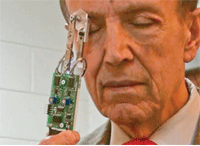A new, easy-to-use home test for glaucoma could provide earlier, more accurate disease detection.

University of Arizona College ophthalmologist and professor Gholan Peyman, M.D., demonstrates a prototype instrument designed to test intraocular pressure. Because it’s noninvasive and simpler to use than current procedures, it could be self-administered and used at home. It may be useful in monitoring the effect of IOP-lowering therapy.
The self-test instrument was designed by Eniko T. Enikov, Ph.D., associate professor at the University of Arizona College of Engineering, and Gholan Peyman, M.D., clinical professor of ophthalmology at the University of Arizona College of Optical Sciences.
“Eye pressure varies over a 24-hour cycle,” Dr. Enikov says. “So, it could be low at the doctor’s office, and three hours later, it might be high. Having the ability to take more frequent tests can lead to earlier detection in some cases.”
Rather than just testing intraocular pressure on the cornea, this probe presses the entire eyeball using a system of micro-force sensors and specially designed microchips.
To use the device, “you simply close your eye and rub the eyelid like you might casually rub your eye,” Dr. Enikov says. “The instrument detects the stiffness and, therefore, infers the intraocular pressure.”
The device could be used regularly at home to evaluate the effectiveness of IOP-lowering therapy, the inventors say.
“The innovation with our device is that it’s noninvasive, simpler to use and applies to a variety of situations that are either difficult to address or impossible to test using the current procedures,” says Dr. Enikov. “That’s why we’re so excited about this probe—it has great potential to improve medical care, and has significant commercial possibilities, as well.”
The National Science Foundation provided funding for the development of this device, and now Drs. Enikov and Peyman are seeking investors to help fund its final development and commercialization.

